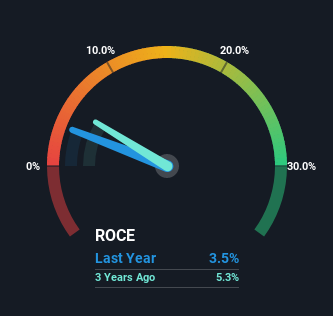- Israel
- /
- Electronic Equipment and Components
- /
- TASE:ININ
Inter Industries Plus (TLV:ININ) Could Be Struggling To Allocate Capital
To find a multi-bagger stock, what are the underlying trends we should look for in a business? Amongst other things, we'll want to see two things; firstly, a growing return on capital employed (ROCE) and secondly, an expansion in the company's amount of capital employed. Ultimately, this demonstrates that it's a business that is reinvesting profits at increasing rates of return. In light of that, when we looked at Inter Industries Plus (TLV:ININ) and its ROCE trend, we weren't exactly thrilled.
Return On Capital Employed (ROCE): What Is It?
For those who don't know, ROCE is a measure of a company's yearly pre-tax profit (its return), relative to the capital employed in the business. Analysts use this formula to calculate it for Inter Industries Plus:
Return on Capital Employed = Earnings Before Interest and Tax (EBIT) ÷ (Total Assets - Current Liabilities)
0.035 = ₪6.7m ÷ (₪446m - ₪254m) (Based on the trailing twelve months to March 2022).
Therefore, Inter Industries Plus has an ROCE of 3.5%. Ultimately, that's a low return and it under-performs the Electronic industry average of 9.3%.
See our latest analysis for Inter Industries Plus

Historical performance is a great place to start when researching a stock so above you can see the gauge for Inter Industries Plus' ROCE against it's prior returns. If you'd like to look at how Inter Industries Plus has performed in the past in other metrics, you can view this free graph of past earnings, revenue and cash flow.
What The Trend Of ROCE Can Tell Us
When we looked at the ROCE trend at Inter Industries Plus, we didn't gain much confidence. Around five years ago the returns on capital were 5.3%, but since then they've fallen to 3.5%. However, given capital employed and revenue have both increased it appears that the business is currently pursuing growth, at the consequence of short term returns. And if the increased capital generates additional returns, the business, and thus shareholders, will benefit in the long run.
Another thing to note, Inter Industries Plus has a high ratio of current liabilities to total assets of 57%. This effectively means that suppliers (or short-term creditors) are funding a large portion of the business, so just be aware that this can introduce some elements of risk. Ideally we'd like to see this reduce as that would mean fewer obligations bearing risks.
The Bottom Line On Inter Industries Plus' ROCE
Even though returns on capital have fallen in the short term, we find it promising that revenue and capital employed have both increased for Inter Industries Plus. These growth trends haven't led to growth returns though, since the stock has fallen 26% over the last five years. As a result, we'd recommend researching this stock further to uncover what other fundamentals of the business can show us.
One more thing, we've spotted 2 warning signs facing Inter Industries Plus that you might find interesting.
For those who like to invest in solid companies, check out this free list of companies with solid balance sheets and high returns on equity.
New: AI Stock Screener & Alerts
Our new AI Stock Screener scans the market every day to uncover opportunities.
• Dividend Powerhouses (3%+ Yield)
• Undervalued Small Caps with Insider Buying
• High growth Tech and AI Companies
Or build your own from over 50 metrics.
Have feedback on this article? Concerned about the content? Get in touch with us directly. Alternatively, email editorial-team (at) simplywallst.com.
This article by Simply Wall St is general in nature. We provide commentary based on historical data and analyst forecasts only using an unbiased methodology and our articles are not intended to be financial advice. It does not constitute a recommendation to buy or sell any stock, and does not take account of your objectives, or your financial situation. We aim to bring you long-term focused analysis driven by fundamental data. Note that our analysis may not factor in the latest price-sensitive company announcements or qualitative material. Simply Wall St has no position in any stocks mentioned.
About TASE:ININ
Inter Industries Plus
Engages in the energy and infrastructure businesses in Israel.
Flawless balance sheet and slightly overvalued.
Similar Companies
Market Insights
Community Narratives


Recently Updated Narratives

Constellation Energy Dividends and Growth

CoreWeave's Revenue Expected to Rocket 77.88% in 5-Year Forecast

Bisalloy Steel Group will shine with a projected profit margin increase of 12.8%
Popular Narratives


MicroVision will explode future revenue by 380.37% with a vision towards success


NVDA: Expanding AI Demand Will Drive Major Data Center Investments Through 2026



